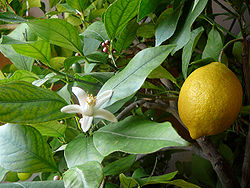Typical yield
17.3 t/ha
Varieties
3
Pest/Disease
9
Seasons
4
Profile
- Growth habit
- tree
- Lifecycle (days)
- Perennial (bearing from year 3–4)
- Primary uses
- Fresh fruit; juice; zest; essential oil
- Pollination
- insect
- Origin / distribution
- Subtropics/tropics; widely grown in East Africa
Environment
Climate
Temp optimal
20–30 °C
Rain optimal
800–1200 mm/yr
Altitude
0–1800 m
Soil
pH optimal
6–7
Soil type
Well-drained loam/sandy loam; high organic matter
Farmer Guide
Row spacing
600 cm
Plant spacing
600 cm
Depth
5 cm
Seed rate
kg/ha
Nursery days
270
Planting: Plant grafted, disease-free seedlings at onset of rains in 60×60×60 cm pits mixed with compost. Keep graft union 15–20 cm above soil. Mulch basins.
Transplanting: Do not disturb root ball; stake young trees; paint trunks to prevent sunburn.
Irrigation: Regular moisture critical at flowering and fruit set; irrigate deeply and infrequently; maintain mulch.
Fertigation: Split N and K into small, frequent doses during active growth; include Ca/Mg where needed.
Pest scouting: Scout for citrus leaf miner, aphids/psyllids, scales, mites, and fruit flies; monitor for HLB symptoms.
Pruning/Training: Form 3–4 scaffold branches; remove suckers below graft; light annual thinning.
Harvest: Harvest when fruit is fully sized and color breaks; pick with clip to avoid tearing rinds.
Postharvest: Handle gently; wash/sanitize; dry and store cool with airflow; avoid ethylene exposure.
Nutrient Schedule
| # | Stage | DAP | Product | Rate | Targets (kg/ha) | Notes |
|---|---|---|---|---|---|---|
| 1 | Basal (at planting) | 0 | Compost + NPK 17-17-17 | 10 kg/tree + 150 kg/ha | N: 20, P₂O₅: 20, K₂O: 20 | Mix compost in pit; keep fertilizer away from trunk |
| 2 | Vegetative split 1 | 60 | CAN 26% N | 60 kg/ha | N: 16, P₂O₅: —, K₂O: — | Ring apply on moist soil; mulch afterwards |
| 3 | Flowering / set | 180 | MOP (KCl) + MAP (12-61-0) | 60 kg/ha (K) + 25 kg/ha (P) | N: —, P₂O₅: 15, K₂O: 40 | Avoid heavy N near bloom |
| 4 | Fruit fill (fertigation opt.) | 240 | KNO₃ / CaNO₃ (weekly small doses) | 8 kg/ha/week | N: —, P₂O₅: —, K₂O: 40 | 4–6 weeks micro-doses improve size/peel |
Nutrient Requirements
| Nutrient | Stage | Amount | Unit |
|---|---|---|---|
| N | Basal | 30 | kg/ha |
| P₂O₅ | Basal | 20 | kg/ha |
| K₂O | Basal | 30 | kg/ha |
| N | Topdress | 60 | kg/ha |
| K₂O | Topdress | 60 | kg/ha |
| N | Vegetative | 40 | kg/ha |
| K₂O | Vegetative | 40 | kg/ha |
| N | Flower_set | 20 | kg/ha |
| K₂O | Flower_set | 30 | kg/ha |
| K₂O | Fruit_fill | 40 | kg/ha |
| N | Maintenance | 30 | kg/ha |
| P₂O₅ | Maintenance | 10 | kg/ha |
| K₂O | Maintenance | 30 | kg/ha |
Images

| Name | Country | Maturity | Traits |
|---|---|---|---|
| Eureka | KE | High-quality fruit; common fresh market | |
| Lisbon | KE | Vigorous; productive under warm conditions | |
| Ponderosa (home garden) | UG | Large fruits; coarse peel |
| Stage | Product | Rate (kg/ha) | Notes |
|---|---|---|---|
| Basal | Compost/manure (well-decomposed) | 5000 | Band in basin; keep 20–30 cm off trunk |
| Vegetative | CAN 26% N | 60 | Split into 2–3 small doses |
| Flower/Set | MOP (KCl) | 60 | Boost K before/after bloom |
| Fruit fill | Calcium nitrate (optional) | 40 | Improve peel/firmness |
| Name | Type | Symptoms | Management |
|---|---|---|---|
| Citrus canker | disease | Leaf/fruit lesions | Sanitation; copper sprays |
| Citrus leaf miner | pest | Leaf mines; distorted flush | Avoid excessive N; prune infested flush; selective insecticides if severe |
| Aphids & psyllids | pest | Curling leaves; honeydew/sooty mold; HLB risk | Control ants; use oils/soaps/selective actives; remove symptomatic shoots |
| Scales & mealybugs | pest | Sooty mold; twig decline | Horticultural oils; prune hot spots; biological control |
| Citrus mites | pest | Bronzing; russeted rind | Maintain tree vigor; targeted acaricides if needed |
| Fruit flies | pest | Stings; larval damage | Protein baiting, field sanitation, traps |
| Citrus canker / greasy spot | disease | Lesions/leaf spots & defoliation | Sanitation; copper/protectants; airflow |
| Phytophthora gummosis | disease | Gum exudation; bark rot at collar | Mound soil; improve drainage; trunk paints; resistant rootstocks |
| Citrus tristeza (CTV) | disease | Decline on susceptible rootstocks | Use tolerant rootstocks; rogue infected trees |
| System | Typical | Min | Max | Notes |
|---|---|---|---|---|
| orchard | 15 | 8 | 25 | |
| rainfed smallholder | 12 | 8 | 18 | Bearing improves after year 4–5 |
| irrigated/managed orchard | 25 | 15 | 35 | Good cultivar, nutrition & pest control |
| Country | Region | Planting | Harvest |
|---|---|---|---|
| KE | Warm mid-altitudes (long rains planting) | Mar–Apr | Multiple flushes year-round |
| KE | Warm mid-altitudes (short rains planting) | Oct–Nov | Multiple flushes year-round |
| UG | Central/Eastern (humid) | Mar–Apr | Staggered harvests |
| TZ | Coastal & northern (unimodal) | Nov–Dec | Staggered harvests |
| Country | Region | Suitability |
|---|---|---|
| KE | Coastal; lower & mid-altitudes with irrigation | High |
| KE | Cool highlands >1900 m (frost risk) | Low |
| KE | Low to mid-altitudes | High |
| KE | Poorly drained clays; waterlogged sites | Low |
| TZ | Coastal; Morogoro; northern valleys | High |
| UG | Central/Eastern sub-humid | High |
